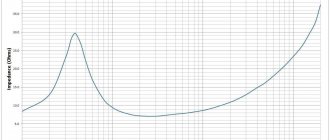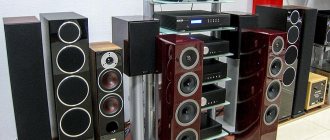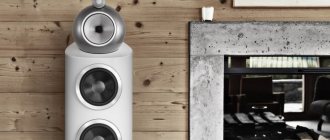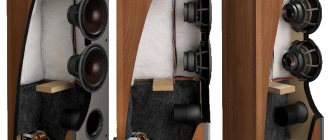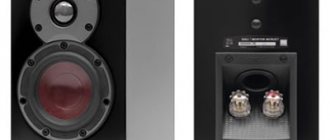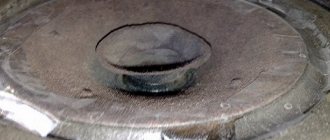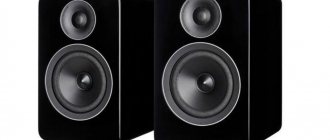HECO (Heco) is a German company producing cabinet, built-in and wall-mounted speaker systems.
The history of the HECO brand began in 1949 in the small settlement of Schmitten (Upper Taunus district, Darmstadt administrative district). Initially, the company's founder, Gerhard Richard Hennel, and his wife Susanne Hennel were engaged in the production of speakers and solid-cast baskets for them.
Their family business was called Hennel & Co (this name later became HECO). In the early 50s, the company began assembling wall-mounted flat speakers for cinemas.
One of the company's first well-known speakers was the compact Type B130 model. Thanks to this product, HECO managed to establish itself as one of the few successful speaker manufacturers of those years.
Hans Hennel and Wolfgang Seikritt
In the mid-60s, the son of Gerhard and Suzanne, Hans Hennel, joined the management of the company. The young man was entrusted with a division specializing exclusively in acoustic systems.
The fruits were not long in coming: the Hi-Fi speakers B 200 and B 300 appeared in the HECO catalog. These two models marked the beginning of a line of speaker systems created by Hans Hennel and engineer Wolfgang Seikritt from Braun.
B 200 and B 300
In the 60s, Seikritt developed the HECO P7302 SLV active three-way system, unique at that time, intended for the most demanding hi-fi enthusiasts. Later, the engineer created several more successful models and lines.
P7302 SLV
Among other things, audio industry experts of those years singled out the Soundmaster B220 (1966). This speaker system with a neutral sound had a soft-dome tweeter and a woofer with an elastic suspension. The B220's combination of elements provided precise bass and clear highs.
The best Heco speakers
Speaker system Heco Aurora 1000
5 1 review
~ 84 900
- Power: 230 W
- Maximum power: 380 W
- Frequency range: 22-42500 Hz
Acoustic system Heco Elementa 700
5 1 review
~ 149 000
- Power: unknown
- Maximum power: unknown
- Frequency range: 25-45000 Hz
Acoustic system Heco Celan Revolution 3
5 2 reviews
~ 99 000
- Power: 100W
- Maximum power: 160 W
- Frequency range: 30-52000 Hz
Acoustic system Heco AM 200
5 0 reviews
~ 39 900
- Power: 40 W
- Maximum power: 100 W
- Frequency range: 50-35000 Hz
Speaker system Heco Celan Revolution 7
5 1 review
~ 229 000
- Power: 220 W
- Maximum power: 350 W
- Frequency range: 21-52000 Hz
Acoustic system Heco Aleva GT 602
5 0 reviews
~ 109 900
- Power: 180W
- Maximum power: 320 W
- Frequency range: 27-42000 Hz
Acoustic system Heco Aurora Center 30
5 0 reviews
~ 15 900
- Power: 90W
- Maximum power: 150 W
- Frequency range: 34-42500 Hz
Acoustic system Heco Aleva GT Center 32
5 1 review
~ 29 900
- Power: 100W
- Maximum power: 160 W
- Frequency range: 35-42000 Hz
Acoustic system Heco Aleva GT 202
4.6 4 reviews
~ 39 900
- Power: 80W
- Maximum power: 140 W
- Frequency range: 36-42000 Hz
Speaker system Heco Aurora 300
4 4 reviews
~ 28 900
- Power: 80W
- Maximum power: 150 W
- Frequency range: 32-42500 Hz
Acoustic system Heco Victa Prime 702
4 10 reviews
~ 36 900
- Power: 170 W
- Maximum power: 300 W
- Frequency range: 25-40000 Hz
Acoustic system Heco Victa Prime 502
4 5 reviews
~ 29 989
- Power: 145 W
- Maximum power: 265 W
- Frequency range: 28-40000 Hz
Subwoofer Heco Victa Prime Sub 252 A
4 6 reviews
~ 29 900
- Power: 100W
- Maximum power: 200 W
- Frequency range: 22-200 Hz
Acoustic system Heco Victa Prime 202
4 7 reviews
~ 12 900
- Power: 65 W
- Maximum power: 110 W
- Frequency range: 35-40000 Hz
Speaker system Heco Aurora 700
4 2 reviews
~ 67 900
- Power: 200W
- Maximum power: 300 W
- Frequency range: 25-42500 Hz
Acoustic system Heco Victa Prime 302
4 0 reviews
~ 16 630
- Power: 85 W
- Maximum power: 150 W
- Frequency range: 33-40000 Hz
Acoustic system Heco Victa Prime Center 102
4 2 reviews
~ 9 900
- Power: 85 W
- Maximum power: 150 W
- Frequency range: 35-40000 Hz
Acoustic system Heco Victa Prime 602
4 3 reviews
~ 34 900
- Power: 160W
- Maximum power: 280 W
- Frequency range: 26-40000 Hz
Acoustic system Heco Ascada 2.0
4 1 review
~ 65 000
- Power: 35 W
- Maximum power: 70 W
- Frequency range: 32-40000 Hz
Acoustic system Heco Aleva 500
4 1 review
- Power: 120W
- Maximum power: 200 W
- Frequency range: 28-42000 Hz
Acoustic system Heco Aleva 200
4 4 reviews
- Power: 80W
- Maximum power: 140 W
- Frequency range: 36-42000 Hz
Acoustic system Heco Music Colors 200
4 1 review
- Power: 140 W
- Maximum power: 220 W
- Frequency range: 30-35000 Hz
Subwoofer Heco Music Style Sub 25A
4 2 reviews
- Power: 125W
- Maximum power: 250 W
- Frequency range: 22-150 Hz
Speaker system Heco Xenon 600
4 1 review
- Power: unknown
- Maximum power: 180 W
- Frequency range: 20-32000 Hz
Acoustic system Heco Metas Center 2
4 1 review
- Power: 100W
- Maximum power: 160 W
- Frequency range: 34-42000 Hz
Acoustic system Heco Vitas 600
4 1 review
- Power: 140 W
- Maximum power: 240 W
- Frequency range: 25-35000 Hz
Acoustic system Heco Celan 500
4 1 review
- Power: 180W
- Maximum power: 300 W
- Frequency range: 24-50000 Hz
Acoustic system Heco Concerto B15
4 1 review
- Power: 100W
- Maximum power: 160 W
- Frequency range: 33-45000 Hz
We've rounded up the best Heco speakers for 2022 based on user reviews and ratings. People's ratings of Heco speaker systems, presented characteristics, video reviews and prices will help you choose the ideal model for you. Enjoy using it!
1…Next
Times of the Rank Organization and Bruns-Gruppe
In the early 1970s, HECO experienced one of the key turning points in its history. The Hennel & Co factories in Schmitten and Remscheid (HECO already had several separate factories) were purchased by one of the branches of the British conglomerate Rank. Thus, the HECO brand became the property of another company.
SMR 720
However, part of the business (Heco Hennel & Co KG in Berlin) continued to remain in the Hennel family - this branch was personally managed by Susanne Hennel. In 1975, the Berlin plant became part of the H. Dahl KG holding. One of the most popular products of Heco Hennel & Co KG was the Visonik speakers (the factory in Berlin produced products for this American brand).
Professional 650
In the 70s, HECO managed to release several receivers of the SMR series, a series of Professional studio speakers, a line of Sound Master acoustics, the Activ series, etc. The Activ 2000 model, thanks to its compactness and high-quality sound, became one of the most popular professional speakers of those times.
Sound Master
In parallel with the arrival of the Rank Organization, Hans Hennel resigned as a top manager of HECO and switched to his own business. He opened his own company under the name Hans G. Hennel GmbH & Co. KG" and some time later began producing speakers under the Summit brand.
Activ 2000 K
Several key employees also left HECO, including Wolfgang Seikritt. Former HECO employees founded their own company, Canton.
In 1979, the business of Heco Hennel & Co KG in Berlin was taken over by Bruns-Gruppe (Peter Bruns' company, which owned several brands in Berlin and Hamburg). In the same year, the Rank group of companies also decided to sell its part to HECO, since the brand did not fit into the concept of the concern.
Return of Wolfgang Seikritt
It is generally accepted that since 1980, HECO's history as a family company has ended. Since then, Hennel + Co GmbH was indicated as the manufacturer of all acoustics (there was no information about the parent companies).
Heco speakers were developed and manufactured in Berlin and Schmitten. In the early 80s, the company's business was not going very well, but in 1985 the serious-minded Wolfgang Seikritt returned to HECO, who decided to restore the company's lost reputation and take up marketing policy.
Superior 630
In 1987, HECO released the first models of the Superior series speakers, which was the main event for HECO in recent years: Superior speakers were positioned as premium products and well established among high-end fans.
On the threshold of the new decade, the company introduced the Megaspace multi-channel system, which later became the basis for other DC sets.
In the early 90s, HECO, along with many other companies, got into car audio: the company produced speakers for cars and amplifiers. This endeavor later grew into a separate brand.
As part of Recoton
In 1995, the Heco Anniversary three-way floorstanders with a piezoelectric HF emitter were introduced. The acoustics were created for powerful systems and had a wide frequency range. The weight of one column exceeded 80 kg. Many audiophiles still consider the Anniversary to be one of HECO's most successful products.
Anniversary
Despite the successful Anniversary model, the company's financial situation was very difficult. As a result, the company went bankrupt, after which the brand was purchased by the American corporation Recoton. The HECO company became part of the German division - Recoton DE.
The new owner changed HECO's strategy. Under the management of Recoton, the company continued to produce existing models and develop new lines. In those years, HECO began making car audio systems under the Phase Linear brand (previously this brand belonged to Jensen).
Metronom
In 1999, HECO introduced the Metronom series of audiophile acoustics, which featured D'Appolito's design.
Speaker systems HECO Tresor
These heavy, but very compact monitors contrast so much with all the acoustics ever produced by the German HECO that the Russian supplier initially had doubts - is it even worth bringing to our market models with a design and price so unusual for a popular brand? Fortunately, this issue has now been resolved - Trezor has a chance to surprise us all.
Let's immediately clarify the issue of cost. 75 thousand rubles for small two-way monitors from a manufacturer known mainly for mass-produced models is, at first glance, of course, a lot. But considering that they also arrived in European retail at a price of 1000 euros per pair, then everything turns out to be fair. And if you also take into account their solid appearance (such high-quality performance is usually found only in top-level acoustics with six-digit figures on the price tag), then “Trezors” generally begin to be perceived as a gift. That’s why, while getting to know these models, I even wanted to compare them with the TAD reference monitors, although these, of course, are things from different planets, differing in cost by an order of magnitude.
Do Trezors justify such advances? The cases are combined - the main frame is made of high-density wood-fiber boards, and the sidewalls are cast thick aluminum panels, tightly secured with screws. The rigidity of such a design is so high that structural vibrations simply cannot occur in it, and this is the first necessary condition for achieving uncolored sound.
You probably noticed that the tweeter is fixed with ten screws, and the midbass with twelve screws. So many fasteners are usually used only where the flanges have to withstand enormous pressure. But here it is not there and it would seem that there is no need to provide maximum tension force for structural elements. With such a number of screws, tightened with a certain torque, another goal is pursued: by uniformly distributing mechanical stress from the flanges and speaker baskets to the housing, a barrier is placed in the way of microvibrations. Is it important? Undoubtedly! The fact is that the amplitude of the signals, which, when reproduced, form what is commonly called a microdynamic pattern, relative to the amplitude of dynamic contrasts (and causing those same vibrations in the body) is tens and hundreds of thousands of times weaker. And if we do not take measures to suppress any systemic “micro-ringing”, we will not be able to obtain natural detail - the nuances will always be transmitted with “impurities”.
The cases are combined - the main frame is made of high-density wood-fiber boards, and the sidewalls are cast thick aluminum panels, tightly secured with screws.
The drivers are all new, having no analogues in the HECO line. The computer optimized tweeter features a 30mm soft dome wide ring element, a dual ferrite system in a liquid-cooled magnet system and a specially shaped Fluktus flange. The cones on its surface, as we have already seen in tests of all new HECO acoustics, are very important - they minimize interference and thereby make the frequency response on the radiation axis more linear, and improve dispersion at wide angles. By the way, the diameter and curvature of the fluktus cavities on the Tresor are different than those of the tweeters used on the latest Celan Revolution and available Aurora series systems, and this directly indicates that HECO engineers optimized the HF driver parameters specifically for these systems.
Midbass is recognizable only by the diffuser, which is made from kraft paper with a proprietary recipe. The suspension, basket, magnetic system (all this can be seen a little through the huge bell of the bass reflex) are also, apparently, special, and this fact already, at a minimum, deserves respect. Tresor models clearly have a special role to play in the entire range, since the company did not save money through unification.
But personally, I was most intrigued by the width of the frequency range - from 35 hertz! I don’t remember bookshelfs of comparable displacement that would promise such deep lows.
The German manufacturer traditionally does not indicate the type and order of crossover filters, only reporting that they are phase-optimized. HECO also insists on the need to provide at least 10 cm of free space behind the monitors and warns about the dangers of using weak amplifiers (and there is a temptation to do so, since small systems have amazingly high sensitivity in their size category). Behind these tips there is a clear desire to demonstrate the dynamic potential achieved in Tresor and the ability to reproduce nuances at the level of quality that can only be expected from high-end audio systems. But personally, I was most intrigued by the width of the frequency range - from 35 hertz! I don’t remember bookshelfs of comparable displacement that would promise such deep lows.
And what’s most interesting is that this actually exists. The transmission of bass by Trezors is generally outside of any “monitor” canons. It is felt that the lowest vibrations have a solid foundation, which allows the systems to easily draw organ compositions that “do not work” even on large floor-standing acoustics. Kicks, bass guitars, double basses are strong and wonderfully separated. Plus, everything that is a little higher adds up to a very clear picture, and the result is a rich, naturalized bass, the character of which is not imposed by monitors, but is dictated by the composition of the instruments in the recording. Cool is not the right word. The only “but” is the volume. At very powerful levels, Trezors can no longer compete with physical laws and begin to reproduce musical material with compression. But just below this problem there is no such thing - a complete illusion of the operation of large and expensive speakers is born.
It is felt that the lowest vibrations have a solid foundation, which allows the systems to easily draw organ compositions that “do not work” even on large floor-standing acoustics.
Let's move on. For me, HECO acoustics are a sound that has a lot of harmonic texture, pleasant density and a lively voice. To this we add detail, wide range, linearity and transparency, if we are talking about German advanced systems (like Celan Revolution). "Trezors" change this formula. Mentally imagine a sound in which texture and detail (and where it is usually lacking - in the bass and midband) are raised to the second power, add naturalness of timbres in the mid/high frequency transition area and add even more atmosphere, and you will get the idea, How does the new model differ from all other products of the brand?
The musical picture is not sleek, but is drawn in all the nuances. In terms of microdynamic elaboration, Tresors differ from conventional two-way monitors, just as good film headphones differ from traditional dynamic ones. All imaginary sound sources fit perfectly into the sound space. Moreover, if instead of the usual “room” arrangement of speakers on stands with a fairly wide stereo base, you switch to a “desktop” arrangement to place the acoustics in the near field (as in our photo), the sound scale will not collapse in any way - on the contrary, a feeling of limitless three-dimensional space will appear. depths.
In terms of microdynamic elaboration, Tresors differ from conventional two-way monitors, just as good film headphones differ from traditional dynamic ones.
This arrangement is optimal for two more reasons. You don't need a lot of power to get full dynamic sound. In addition, as you know, the less we shake the walls in the room, the cleaner the sound field at the listening point. We also get an excellent (yes, I’m using the epithet again, but it’s appropriate here) correspondence of the harmonic picture to the spatial one, which gives a very plausible musical balance. If, while listening to music on Trezors, you have a persistent illusion that it is not small speakers nearby that actually sound, but large ones at a decent distance, then you have achieved the correct placement. And it won’t matter much anymore that the tonal balance of the babies is slightly (and, apparently, intentionally) different from inexpensive HECO monitors. In particular, the slight drop in frequency response at 200 - 300 Hz will not be detected, the emphasis on bright tones in the upper middle, the slight lightening at the top will disappear - trebles will sound sparkling, rich, but without embellishment.
These differences indicate a special intention in the new German acoustics - to provide full-scale reproduction at a limited volume. Maximum volume, maximum frequency width, but all this with comfortable dynamics. This is right. In the end, even professionals try to “monitor” at levels of no more than 96 - 100 dB, so as not to make mistakes from simple fatigue caused by high volume. And “Trezors” are able to show a very detailed and detailed musical picture and at even more delicate levels. Well, isn't it a godsend for the attentive listener?
SYSTEM
Sources
- Denon DCD-2500NE player and DNP-800NE streamer
- laptop Apple MacBook Air A1465
- Integrated amplifier/DAC Denon PMA-2500NE
Cables
- interconnect InAkustik Referenz NF-2404 RCA
- acoustic InAkustik Referenz LS-2404 Air
- digital USB InAkustik Referenz High Speed USB 2.0 and Oehlbach XXL 80 TOSLink
- power InAkustik AC-1502
HECO Tresor
Manufacturer: Magnat Audio-Produkte GmbH (Germany)
www.heco-audio.de
Configuration: 2 emitters, 2 bands || Acoustic design: bass reflex || Frequency range: 35 - 48000 Hz || Sensitivity: 90 dB || Resistance: 4 - 8 Ohms || Crossover frequencies: 3500 Hz || Nominal/maximum power: 80/140 W || Recommended amplifier power: from 30 W || Finish: black lacquer (front and top panel) and anodized aluminum (sides) || Dimensions: 202 x 298 x 282 mm || Weight 1 piece: 8.2 kg || Price per pair: 75,000 rub.
share
Tags: HECOHECO TresorExpert's Choice

